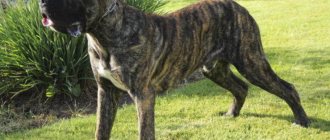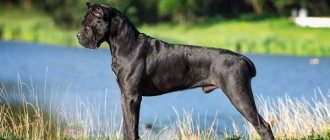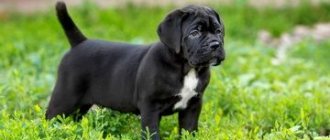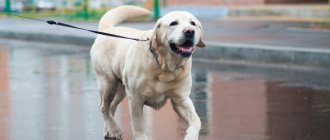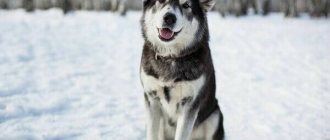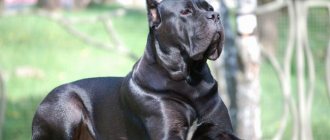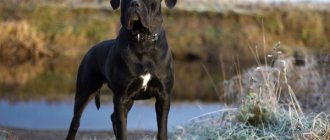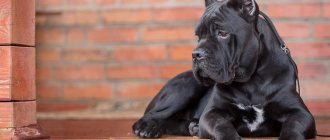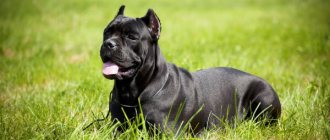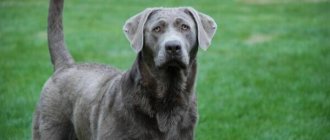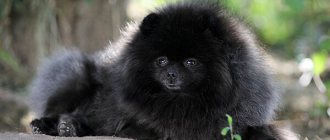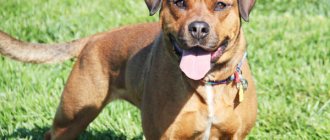The Cane Corso has an unusually interesting history: this breed was elevated to the pedestal of honor during the times of the patricians and practically disappeared after the change of power. And only the enthusiasm of Italian breeders helped save the unique descendants of the ancient Molossians.
But since there was not enough genetic material to quickly and completely recreate the breed in its original appearance, the blood of the Great Dane, Mastino Napoletano, Boxer and Staffordshire Terrier were infused into the breed . This made it possible to revive the Cane Corso in a short time (the photo will be published below), but gave its representatives some diversity.
Features of the breed, pros and cons
It was the combination of such different phenotypes, each of which brought something special, some unique note to the breed, that led to the fact that there is a clear division in the breed .
Within one standard, dogs can have the features of a Great Dane, Mastiff or Boxer, and in ninety percent of cases this difference is accompanied by a color characteristic of the breed.
For example, when purchasing a black puppy, you need to be prepared that he will have an elegant build, a dry head and the aristocratic disposition inherent in a Great Dane. A brindle puppy will be squat and tireless, while a gray puppy will have powerful bones and a large head, characteristic of a Mastino.
But these differences are conditional and are only a hint of their ancestors, and in general, all representatives of the breed have their own characteristics, advantages and disadvantages inherent in the breed. The advantages can be considered:
- Amazing plasticity of the puppy's psyche. A baby can be taught to be distrustful of strangers, and the grown dog will become an excellent guard. Or you can raise a stranger-friendly companion who will happily greet everyone who comes into the house.
- Calm, loyal attitude towards children. An adult dog is affectionate towards children growing up in his family.
- The desire to take care of all family members, to always be close to the person. The Cane Corso is a family dog who loves to be in the company of his family.
- The Cane Corso is easy to keep, does not require labor-intensive care, and has good health.
Experienced owners consider the following disadvantages:
- Relatively difficult to train, as they are independent and rather stubborn dogs.
- Excessive affection and loyalty of the pet. An adult pet can hardly tolerate the departure of its owners, even for a short time, and a change of owner for a dog is a huge tragedy. After a year, it is very difficult for a dog of this breed to get used to a new family.
- Drooling. The Cane Corso's muzzle is such that after drinking, eating or barking, drool flows in large quantities.
- Short hair. Smooth-haired dogs cannot live outside, do not tolerate frost well and need overalls during winter walks.
Selection rules
The long-awaited day has come when you have to choose a suitable Cane Corso puppy. Appearance and your own “like/dislike” feelings are not enough. The issue of choice should be approached more responsibly. Five rules will help with this.
- A personal meeting. In the age of the Internet, it is difficult to force yourself to travel even to the other end of the city to personally find out all the issues. It’s easier to negotiate online and receive a puppy somewhere closer to home. However, showing laziness already at the first stage of purchase is a big mistake. Firstly, how to raise a new family member with such a careless approach? Secondly, only a personal meeting will convince of the competence of the nursery owners. Thirdly, it is important to see with your own eyes how pets are kept and behave. Not a single photo, even the highest quality, will tell about the character of a puppy.
- Verification of documents. Each puppy must have a standard set of documents. First of all, a puppy card indicating age, gender, external parameters, information about parents, and possible shortcomings. The address, telephone number of the nursery, and the name of the owner are also indicated. In addition, a veterinary card is issued indicating all vaccinations given, and a purchase and sale agreement. Documents must be certified by the seal of the nursery. The puppies themselves are microchipped and have a mark on their belly.
- Pet behavior. Puppies should be active, well-fed, mobile and cheerful. Shiny smooth coat, clean eyes, nose and ears indicate health and good care. Quiet, shy or aggressive behavior should alert future owners.
- Conditions of detention. Breeders are the parents of their pets, they try to create ideal conditions for them. Concrete narrow cages, dirty bowls and bedding, and a cold room are not the most favorable conditions for dogs. Such content may affect your health.
- Choice of gender. In character, “boys” and “girls” differ little from each other. A dog of any gender will show excellent qualities as a watchman and security guard. However, some nuances of behavior should be taken into account. Bitches, as a rule, are more reserved, attentive and caring. Males are often stubborn and capricious, especially during puberty, and therefore require stricter training. “Boys” are often chosen: it is believed that they are more “masculine” and do not cause problems with unwanted offspring. But bitches can also avoid unwanted mating if the owners do not want to breed puppies. In addition, estrus occurs only once every eight months. Modern means make this period comfortable for both the dog and the owner.
The optimal age for purchasing a puppy is one and a half months. The breeder, when parting with the pet, will definitely tell you about all its features, tell you what to feed and how to care for it.
Cane Corso mixed breeds and breed varieties
A Cane Corso that has a pedigree cannot be considered a mestizo, even if its appearance shows a connection with other dog breeds. This is due to the relative youth of the breed, with heterogeneity that will disappear over time. Currently, we can talk about the following types or different types of Cane Corso :
- The type is mastiff. Tall-legged, slender, narrow-chested, with a small, light head, long muzzle and longer ears. It has a calm, slightly touchy character, a very good memory and is extremely attached to its owner.
- Mastiff type. Raw type of constitution, loose, with developed muscles and skin forming folds. The head is large, with raw lips and eyelids. The character is calm, slightly phlegmatic, lazy. A very good guard, can't stand the heat very well.
- Bullmastiff type. The dogs are heavy, loose, with muscular, wide chests and backs. The head is round in shape with an abundance of folds on the muzzle and raw lips. The eyes are small and close set. The character is stubborn, active.
- Boxer type. Dogs of this type are distinguished by a square body format, without excessive muscle load. The type of constitution is rather strong dry. The head is small, the eyes are large, round, and set wide apart. The character is active, cheerful and eccentric.
- Type of Staffordshire Terrier. The general body structure is within the standard, wide muscular chest and back, the main difference between this type is the wedge-shaped muzzle. This type is the most aggressive towards surrounding animals and is highly active.
Important! A true Cane Corso mix is a puppy that has only one parent of the Cane Corso breed.
Diet
The menu of fighting dogs mainly consists of ready-made dry food. This is due to the fact that Cane Corsos often suffer from allergic reactions to natural food. The main disadvantage of this feeding method is the high cost of hypoallergenic feed.
To check for food allergies, natural foods are added to the diet. The composition of the menu is influenced by the state of the animal’s body, age, mobility and time of year. After purchase, the dog is allowed to try new products only after two weeks.
Puppies are fed several times a day, maintaining equal intervals. As a rule, the diet consists of lean meat (veal, rabbit), sea fish and boiled chicken eggs.
Comparison with other breeds
The impressive dog can easily compete with other guard and service breeds and play the role of a family pet and companion. Compared to other dog breeds, Cane Corso dogs have the following characteristics :
- The level of attachment to family members and the owner of the Cane Corso is higher than that of a German Shepherd or Labrador, the same as that of a Doberman Pinscher or Great Dane, and lower than that of a Boston Terrier or Shih Tzu.
- ' training abilities are higher than those of a bulldog or Newfoundland, on par with a Cane Corso or Doberman, and lower than those of a Labrador or Border Collie.
- The activity level is higher than a St. Bernard or Central Asian Shepherd, on par with a German Shepherd, and lower than a Doberman or Labrador.
- Aggression towards animals is higher than that of a Labrador or Great Dane, on a par with the Central Asian Shepherd or Boxer, and lower than that of a German Shepherd or Doberman.
- Security qualities are higher than those of other companion breeds, on the same level as Great Dane or Mastino and lower than those of Doberman Pinscher or German Shepherd.
- Cane Corso are physically strong dogs, their level of muscular strength is higher than that of Akita Inu or Doberman, Cane Corso and Rottweiler are on the same level, and Mastino or St. Bernard are much stronger.
Appearance
In accordance with the general appearance of the breed, Cane-Corso dogs have an above average build, strong and strong, quite elegant, with lean and powerful muscles. Important ratios include the length of the head, which is about 36% of the height of the animal at the withers.
The format of an adult dog is somewhat stretched . Fans of the Corso breed most of all value endurance and incredible functionality in such dogs, as well as the complete absence of any excess in form and enormous performance.
Standard colors
The official standard indicates that the color of the Cane Corso can be as follows :
- Black. Cane Corso black is the classic, common color of dogs of this breed. Black color is dominant, but the standard allows the presence of a small white spot.
- Brindle. It can look almost yellow with sparse stripes, have a rich red tint, and the brindle Cane Corso can look almost black if the dog has a black relative. This color is called black brindle in the Cane Corso.
- Grey. Gray solid color of various shades - from lead to blue, slate gray or asphalt - is just a lightened black color. The Cane Corso is gray, like the blue Cane Corso, and may have a light nose and lightened eye color.
- Ginger. The entire palette of red color of all shades fits into just three standard names: light red, dark red and murugi. The red Cane Corso can have a blue or red mask, varying in color intensity.
Italian bracca diseases
Italian Braccas are for the most part strong and healthy animals, but the characteristics of their body and purpose create an increased risk of certain problems:
- Dysplasia of the hip and elbow joints. A large body on tall thin legs, increased activity, and even more so working with hunters in forest or mountainous areas - all this indicates a heavy load, and if the dog has a genetic predisposition, then the risk of dislocation of the head of the bone is very high. The development of the problem is indicated by stiffness in the pet’s movements, changes in its gait, and deformation of the limbs. A timely visit to the veterinarian will eliminate the unpleasant symptoms of the disease and neutralize the risk of immobilizing the dog. Both conservative and surgical treatment are allowed.
- Gastric volvulus is a consequence of increased activity after a heavy meal. A dog with this problem begins vomiting, bloating and pain. The only way out in such a situation is surgery.
There is one hereditary disease that is often found among Italian Braccos - von Willebrand disease, characterized by the occurrence of spontaneous bleeding due to a blood clotting disorder. The disease requires constant medication.
Rare and unusual colors
, the concepts of “formentino” or “apricot” colors have increasingly appeared . In fact, there are only four main colors in the standard, but in real life there are a lot of variations in shades of Cane Corso wool. Consequently, the color of the Cane Corso can only be as established by the standard.
The Cane Corso Formentino is a red-colored dog with a gray or blue mask. Blue in this case is understood as light gray. Interestingly, Formentino puppies are born blue or gray, which fades to fawn with age, leaving only a gray mask.
The apricot-colored puppy is a fawn Cane Corso. Fawn is also a shade of red, so there is nothing surprising or rare about the color of such a dog. In the Miniature Poodle breed, the color name is “apricot”, but in the Cane Corso it is much more correct to call it red or light red.
Important! White Cane Corso – breeding marriage. There should not be a white color in the breed, since the gene responsible for the white color carries mutations and is considered lethal by breeders. White dogs of this breed are culled, and the puppies are given documents that do not allow breeding activities.
When choosing a puppy or dreaming of a pet of apricot or formentino color, you should take a closer look not at the color of the future pet’s coat , but at its constitution. The future star of the ring, an excellent breeding sire, may have the most common black color, but have a perfect exterior. A baby of a fashionable and rare color may have significant defects in appearance and spend his life as a pet.
Top nicknames
A pleasant and at the same time difficult moment when getting a dog is choosing a suitable name. The nickname should suit the breed well, emphasize the characteristics of the pet, and at the same time be sonorous and beautiful to the ear.
The Cane Corso is a majestic and noble dog with the habits of an aristocrat, so the name should match. Keeping in mind the origin of the breed, you can choose sonorous Italian names. The table below gives examples of nicknames for your favorite male or female dog.
Table - Pet name options
| Nicknames for Cane Corso “boy” | Nicknames for Cane Corso “girls” |
| — Argon; — Andrea; — Bonya; — Vinci; — Hector; — Django; - Prince; — Leonard; - Mauro — Pepito | - Aina; - Beatrice; — Betty; - Valencia; — Gabrielle; - Ghersi; — Irma; — Loya; — Naomi; - Erika |
In order for the animal to quickly get used to its name, it is worth naming the pet exclusively in a positive way. When punishing, it is better to avoid calling him by name, otherwise his own nickname will cause stress and guilt in the dog.
